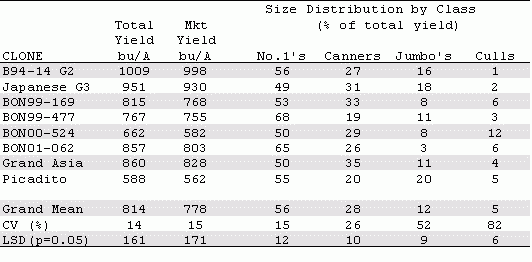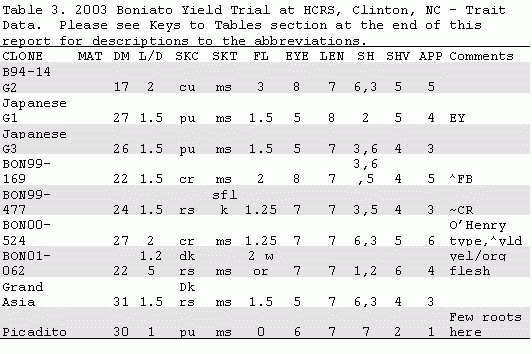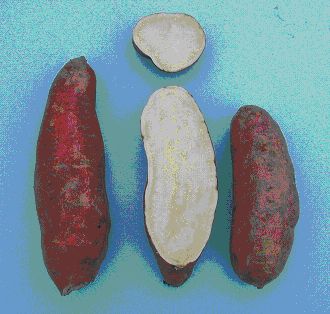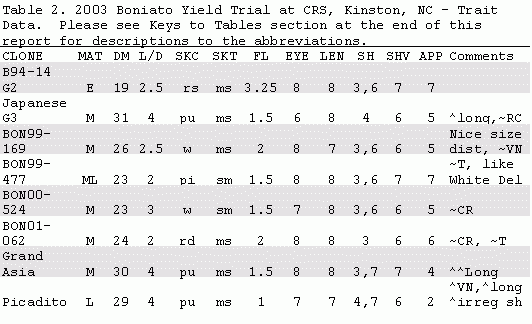Identifying Boniato-Type Sweetpotato Cultivars Adapted to NC Growing Conditions-2003 Report
go.ncsu.edu/readext?451630
en Español / em Português
El inglés es el idioma de control de esta página. En la medida en que haya algún conflicto entre la traducción al inglés y la traducción, el inglés prevalece.
Al hacer clic en el enlace de traducción se activa un servicio de traducción gratuito para convertir la página al español. Al igual que con cualquier traducción por Internet, la conversión no es sensible al contexto y puede que no traduzca el texto en su significado original. NC State Extension no garantiza la exactitud del texto traducido. Por favor, tenga en cuenta que algunas aplicaciones y/o servicios pueden no funcionar como se espera cuando se traducen.
Português
Inglês é o idioma de controle desta página. Na medida que haja algum conflito entre o texto original em Inglês e a tradução, o Inglês prevalece.
Ao clicar no link de tradução, um serviço gratuito de tradução será ativado para converter a página para o Português. Como em qualquer tradução pela internet, a conversão não é sensivel ao contexto e pode não ocorrer a tradução para o significado orginal. O serviço de Extensão da Carolina do Norte (NC State Extension) não garante a exatidão do texto traduzido. Por favor, observe que algumas funções ou serviços podem não funcionar como esperado após a tradução.
English
English is the controlling language of this page. To the extent there is any conflict between the English text and the translation, English controls.
Clicking on the translation link activates a free translation service to convert the page to Spanish. As with any Internet translation, the conversion is not context-sensitive and may not translate the text to its original meaning. NC State Extension does not guarantee the accuracy of the translated text. Please note that some applications and/or services may not function as expected when translated.
Collapse ▲This is a 2003 report from a NC Specialty Crops Program Project. It is posted for historical reference purposes.
Reviewed by Jeanine Davis, NC Alternative Crops & Organics Program, Department of Horticultural Science, NC State University on 10/11/2022.
PROJECT LEADER(S): Kenneth Pecota, Bill Jester and Craig Yencho
TYPE OF PROJECT: Research
LOCATION: Cunningham Research Station, Kinston, NC and Horticultural Crops Research Station, Clinton, NC
IMPACT
The growing Asian and Hispanic segments of the U.S. population represent an expanding market for specialty vegetables. The so-called “Boniato-type” sweet potato is a popular crop among these ethnic groups, but is not typically grown in the U.S. This study was designed to assess the suitability of various boniato-type sweet potato varieties for production in North Carolina. Eighteen varieties were evaluated based on measures of quality, yield, appearance, and disease susceptibility. The cultivar ‘Japanese’, a variety for Asian markets, was found to be the most promising. The cultivar ‘Picadito’, suitable for Hispanic markets, shows limited adaptation to NC growing conditions. Through appropriate selection of cultivars and attention to the disease susceptibility of each variety, North Carolina growers can become leading producers of these specialty sweet potatoes.
INTRODUCTION
The Asian and Hispanic segments are the fastest growing sectors of the U.S. population. Per capita, these groups consume larger quantities of sweet potatoes compared to our nation’s current demography. However, Asian and Hispanic consumers prefer different types of sweet potatoes than what is typically grown in the U.S. These types of sweet potatoes are often referred to as “Boniato-types”. Sweet potatoes suitable for Asian and Hispanic markets have high dry matter, white to cream flesh, and are more similar to a potato in texture and taste than the orange-fleshed sweet potatoes typically grown in N.C. They differ from the white-fleshed sweet potatoes grown here in that they generally have purple to red skin and have a milder flavor. The Asian and Hispanic varieties look similar but differ in sweetness. Asian markets typically have sweet potatoes that are sweet when cooked, while the Hispanic varieties are usually non-sweet. Currently, there are no available Boniato-type varieties that are well adapted to NC’s climate. Part of the reason for this is that most of the growing regions for this type of sweet potato are semi-tropical or tropical. Also, most Boniato-type varieties are typically very long season, not resistant to soil rot, and do not store well.
METHODS
Over 40 plant introductions and breeding lines have been evaluated and rejected over the past four seasons. This year’s yield test included 20 clones, 12 from the North Carolina State University breeding Program, one from Japan, two from the Philippines and five known cultivars. The test was grown in two locations, the CRS in Kinston and HCRS in Clinton. Yield data was not taken at Clinton due to very low yields and high variability from rep to rep. The frequent rainfall produced a severe yield gradient in much of our plantings at the HCRS this year. The tests were graded for yield by No.1, canner, jumbo and cull classes and evaluated for horticultural characteristics including maturity, shape, shape variability, skin color, flesh color, eyes, lenticels, diseases present, length/diameter ratio and overall appearance. All of the clones were also entered into our disease screenings for root knot nematodes, Fusarium wilt and pox.
RESULTS
Eight of the 12 NC State lines were dropped due to poor adaptation, poorly shaped roots, significant appearance problems (such as cracking, skin discoloration, etc.), and low yield. Of the four remaining, two are white skinned, one red and one pink skinned like ‘White Delite’. All will be re-tested next year to see how consistent they are over a range of growing conditions. Three are resistant to both Fusarium wilt and the southern root-knot nematode. The fourth is resistant to Fusarium but susceptible to nematodes. The SSR or pox test is being rerun in the greenhouse, after the first one failed. Due to the rainy summer, our field SSR trial produced only a very low disease incidence and was not rated. None of these new clones have been tested enough to replace the clone ‘Japanese’ which was identified by this project earlier as the best cultivar currently available for NC growers. The Japanese and two Phillipino clones in this year’s trial were discarded for poor adaptability. Selected clones and their yield and appearance ratings are included in tables 1-3 below.
The most popular Boniato-type sweet potato is ‘Japanese.’ However, one of the weaknesses of ‘Japanese’ is its susceptibility to russet crack. It declines rapidly for yield and appearance making the use of clean stock very important. One of our goals for this year was to clean up ‘Grand Asia’ which is similar to ‘Japanese’ since we have not seen russet crack expressed in this clone, however meristemming was not enough to clean it up in time for this season’s test. Yields were comparable to G3 ‘Japanese’, and we are still pursuing clean ‘Grand Asia’ for evaluation. No russet crack was observed in any of the clones selected for further testing.
The main cultivar used for the Hispanic market, ‘Picadito’, performed poorly in both locations, with an appearance rating of 2 (out of 10) in Kinston and 1 in Clinton. Shapes were long and irregular shaped, and heavily veined. It was the lowest yielding line that was measured in this test. We do not recommend this clone for NC growers because of its poor adaptability.
Taste tests are planned for the beginning of the new year. The dry matter of the NC State material is considerably lower than either ‘Japanese’ or ‘Picadito’, 22-27% versus 30-31%. Dry matter is related to texture to some extent, with higher dry matter lines tending to have drier textures. The culinary quality will be compared to the standards and lines dropped if not suitable.
CONCLUSION
The best available sweet potato cultivar suitable for Asian markets in NC is ‘Japanese’. ‘Picadito’ is the most widely grown cultivar for the Hispanic markets, but it has limited adaptation to NC. Both are susceptible to root knot nematodes and soil rot or pox disease. ‘Picadito’ is also susceptible to Fusarium, while ‘Japanese’ is susceptible to russet crack. Because of the disease susceptibilities, each variety should be grown with a sound rotation program and clean planting stock. Virus-indexed micropropagated plants are available from the NC State Micropropagation unit. Contact Zvezdana Pesic-VanEsbroeck at 919.515.7781.
In order to take advantage of the growing Hispanic and Asian markets for sweet potatoes, NC growers need adapted cultivars suitable for these markets. Last year at least eight growers grew ‘Japanese’, ‘Picadito’ or both with an acreage estimated to be greater than 300 acres. One grower produced 200 acres of Japanese for use as chipping stock in addition to the fresh market. We believe that the potential for these markets has not been reached and that, given suitable cultivars, NC could be a leader in the production of these types of sweet potatoes.
PHOTOS AND FIGURES

Table 1. 2003 Boniato Yield Trial at CRS, Kinston, NC. Planted: 17Jun03; Harvested: 17Oct03; Days to Harvest: 122.

Keys to Tables
Storage root data: MAT=maturity E=early, M=mid and L=Late; DM=percentage dry matter; L/D=length/diameter ratio; SKC=skin color clr=clear cu=copper, lt=light, or=orange, pi=pink, pu=purple, rd=red, rs=rose, tn=tan wh=white; SKT= skin texture, m fl= moderate flakiness of skin, lt fl= light flakiness to skin, ms=moderately smooth, sm=smooth; FL=flesh color (0-5 scale where 0=pure white, 1= cream, 2=yellow, 3= medium orange, 4=deep orange, 5= very deep orange; EYE=eyes(0-9); LEN= lenticels (0-9); SH=Shape (see diagram); SHV=shape variability(0-9); APP=overall appearance (0-9). All 0-9 scales go from low or poor to high or good.
Comment codes: AT=tough attachment; B=bumpy shapes; BR=breeding only; BSR=bacterial soft rot; CR=cracking; CRK= crooked shapes; CS=circular spot; CV=skin color variation end to end; D=drop; EY=deep eyes; FB=flea beetle damage; HC=horizontal constrictions; ID=unspecified insect damage; IRR=irregular; JL=jumbo’s for length; L=long; LE=lenticels; LG=longitudinal grooves; LR=Lateral rings; LT=latex; MSH=misshapen roots; NS=nice shapes; OV=ovate or pear shapes; PI=pimples (0-9); PN=pencil roots; PP=pulled plants; R=rodent; RC=russet crack; RG=restaurant grade; RH=root hais; RKN=root-knot nematodes; RSK=rough skin; RT=rot; SD=skin discoloration; SH=sheen; SG=string roots; SK=skinning; SO=souring; SPR=sprouts; SR=soft rot; SS=stays short; SSR=streptomyces soil rot; STR=Striations; T=tails; TP=tapered roots VN=veins; SC=scurf; SF=surface Fusarium; WB=whitefringed beetle; WG=white grub; WW=wireworm; YCR=yellow cortical ring; YLD=yield; 2oR=secondary roots.
(Rating scale: 0 = very severe to 9 = absent)
Shapes






